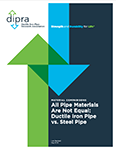WHAT'S THE DIFFERENCE?
Ductile Iron Pipe
vs Steel Pipe
You need to consider much more than just up-front cost when determining which pipe material is best for your infrastructure project that will be delivering water, our most important resource, to a community for generations to come. Choosing the wrong pipe material can result in premature failure, expensive maintenance, and unanticipated costs over the service life of the pipe after installation.
When comparing Ductile iron to steel pipe for water distribution systems, objective comparisons of these two materials show Ductile iron pipe’s conservative design and ease of installation make it the natural choice.
ENERGY EFFICIENCY
- The inside diameter of Ductile iron pipe is typically larger than steel pipe. This means lower pumping costs and an average 21% savings in energy costs over steel pipe.
INSTALLATION
- Ductile iron pipe is strong and resilient, and does not require extraordinary considerations when installing. Steel pipe, on the other hand, is not stiff or strong enough to stand on its own, without braces being placed inside the pipe to make it hold its shape.
CORROSION CONTROL
- Cement-mortar lined Ductile iron pipe, wrapped with V-Bio® enhanced polyethylene encasement at the job site easily provides protection from corrosion. Steel pipe needs bonded coatings applied for corrosion control at the time of manufacture. It is practically impossible to deliver bonded coated steel pipe to a job site without experiencing some coating damage from shipping and handling.
Learn more about the important differences between Ductile iron and steel pipe for your water distribution system needs. Fill out the form below to get in contact with the DIPRA Regional Engineer in your area.
Learn more about the important differences between Ductile iron and steel pipe for your water distribution system needs.
More Resources
Check out this resource for more information.

Ductile Iron Pipe vs. Steel Pipe
Perhaps the most striking difference between Ductile iron and steel pipe is the relative way their internal pressure designs are modeled. Only Ductile Iron Pipe has a standardized design procedure (ANSI/AWWA C150/A21.50), and the approach in that standard is the most conservative in the piping industry.
